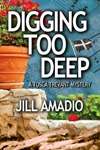|
Back
02/06/2014
Jill Amadio: Digging Too Deep. A Tosca Trevant Mystery
Mainly Murder Press, PO Box 290586, Wethersfield, CT 06129-0586

Real mysteries are a moto perpetuo throughout musical history. Centuries later, we still ask, “Was Mozart poisoned?”, “Did Tchaikovsky kill himself?”, “Was Jean-Marie Leclair stabbed by his wife or his gardener? ‘How did Carlo Gesualdo get away with murdering his wife’s lover?”
Arnold Schoenberg was never involved in an actual murder (though critics still accuse him of mutilating music). But a book of fictional crime was published last month, involving, if not Schoenberg himself, a fragment of his music and his eccentric idiosyncrasies.
Author Jill Amadio, better known for her celebrity biographies, has written her first murder mystery, Digging Too Deep, with a detective who hails from the home of Tristan and King Mark, Cornwall. From her name (Tosca Trevant) to her occasional humming (usually from Puccini), Tosca Trevant is imbued with music. And this knowledge helps her solve her first crime in America.
Tosca Trevant is London-based oxymoronic high-class gossip columnist. Having discovered some dirty doings in Buckingham Palace, she is sent packing to America before she gets in serious trouble. In her daughter’s home amidst the flowers and yachts of southern California, she drinks endless Cornwall mead, utters Cornwall oaths (printable but unpronounceable) and looks for gossip. Instead, she discovers murder (or murders) all over this land, from sunlit beaches to arid deserts to decorative little canisters.
In most murder mysteries, we don’t know the killer until the end. But in Digging Too Deep, Ms. Amadio gives away the killer from the beginning, though we don’t yet know his victims. But here, for ConcertoNet readers, is the good part. The killer is….(long fermata, roll of tympani, whispering buzzings of E-flat tubas) the most distinguished composer in all Southern California.
Professor Haiden Whittaker is obese. In Ms. Trevant’s immortal words, she has never met “a more globular man…made up of a series of circles. Head like a Halloween pumpkin… sitting on a neckless spherical torso and a rotund belly, attached to fat bulbous legs.”
(Methinks the evil Professor makes Max Reger seem positively emaciated.)
But we see why, when he goes by himself to a Thai restaurant, indulging in “coconut soup with mushrooms, shrimp in sweet chili sauce, pineapple fried rice, garlic chicken and three bottles of beer.”
Does he feel full? Does he throw up? No, he has enough energy to take a tire iron and murder a kid who has stolen a rare coin from him, then putting the body in an overturned boat on the beach, before going home to a nice sleep.
Tosca Trevant hadn’t known this before she was snooping in his garden, finding what look like fossilized fingers, giving them to the skeptical police of the town. Now things get down and dirty.
An ex-FBI agent takes her seriously, Professor Whittaker–who always seems to be playing Debussy on his Grand Piano–takes her with fear.
But where is Arnold Schoenberg in all this?
Aha! On the wall of the Professor’s home is an unnamed fragment of music paper. Tosca Trevant immediately recognizes it as a twelve-tone scale. Even more crucial, there are arcane numbers attached to each note of the scale.
Well, our snooping detective/gossip-writer knows that Mr. Schoenberg took numbers seriarlly…I mean seriously. And that Schoenberg had a fear of the number 13. Therefore, he may be history’s first and only triskaidekaphobian-dodecaphonist!
Digging Deep continues from here, deciphering the numbers, running into the desert, encountering a few more bodies, discovering that the Professor may have a secret accomplice in his ghastly deeds, and finishing in a rather ghastly way itself.
One must congratulate Ms. Amadio on her eclectic knowledge. Not so much in music, which I found rather simplified. But on the flora and fauna of Southern California. In detail, she goes over each garden box, the trees on the beach, and then the secret vegetation of an eerie desert setting.
Since this is a detective book, for beach-reading, or during the Adagios of a Bruckner symphony, verisimilitude is irrelevant. I refuse to check whether Anzo-Borrego is a real desert, if Isabel Island is a real island, or whether A-barth en Jowl is a real Cornwall curse. (The only words of Cornish which I am familiar with are “O sink hernieder, Nacht der Liebe”)
But Ms. Amadio, in apparently her first work of fiction, charts a vast amount of geographical territory, and she has a Debussy-playing villain who could change “La Mer” to “La Merde” with hardly a flick of the fingers.
To this, she adds a tale of ghastly derring-do to the canon (if not the fugue) of musical murder most defiling.
Harry Rolnick
|